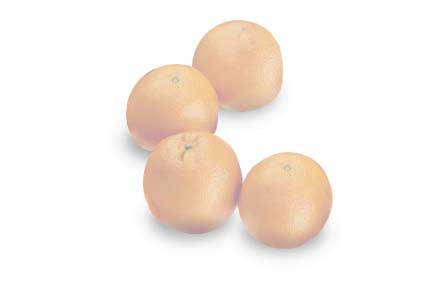













MERCHANDISING
displays
The basics: Oranges may be hand-stacked in similar sizes or gently dumped into bins for fairly massive displays.
Displays that incorporate a variety of in-season citrus items are workable and eye appealing. Use bulk and bagged product to add to impulse sales.
Halve an orange, display one half with the butt end up and one down so shoppers can see the interior, and shrink-wrap it.
Display oranges on end aisles or in a waterfall cascade to increase sales.
According to marketing studies, most orange purchases are impulse sales; thus displays should catch the consumer’s eye. Keep displays neat, clean and attractive, and make sure all produce is top-quality. Check displays to ensure no damaged or poor-quality product is present.
Orange graphic bins are available in small and large sizes and are excellent in merchandising the fruit. These bins can be used for front lobby displays as well.
A tinge of green or "regreening" is normal for ripe oranges during warm weather. A cut orange will reassure consumers the fruit is ripe.
Display fruit-cutting tools, such as graters, peelers and zesters, nearby.
Fresh fruit baskets are good gift suggestions for any holiday.
value-added
Squeezing orange juice in view of shoppers generates impulse sales. Glass pitchers show off the juice. Valencia oranges are good for juicing as well as for eating. If navel oranges are used, serve within about four hours of juicing.
Although an orange nearing the end of its shelf life may have blemishes, it still is suitable for juicing. However, avoid using cracked or decayed fruit for juicing; the bad taste can ruin the entire batch. Refrigerate oranges before squeezing to lengthen the shelf life of the juice.
Promotion
Because some consumers think peeling an orange takes too much time, demonstrate how easy it is to cut an orange for snacking. Halve an orange and cut three or four wedges from each half.
Nutrition
In addition to providing grams and Daily Values, nutrient content descriptors can inform consumers if a nutrient level is considered high or low.
When using a nutrient content descriptor, Food and Drug Administration labeling laws state that the descriptor should be used as in this example: broccoli, a low-sodium food, or broccoli, low in sodium, etc. The statement low-sodium broccoli implies that the broccoli is different or specially prepared. Do not use that type of misleading statement.
Nutrient content descriptors allowed for oranges include: fat-free, saturated-fat-free, sodium-free, cholesterol-free, high in fiber and high in fiber and high in vitamin C.
Foodservice
Oranges are a natural for fruit salads and in drinks, but they are used in everything from appetizers to desserts. When brushed on meat, fish or poultry, it enhances the flavor. Orange shells and baskets make attractive garnishes and are good holders for dips and dressings.
It is easier to peel citrus if it is steamed for a short time. Steaming loosens the membrane and facilitates peeling without injury to the fruit. Place oranges in a pan, one layer deep, and steam for two to four minutes. Cool for one minute. Score peel of fruit into quarters. Do not pierce fruit. Remove peel with fingers.
types
Valencia
Few seeds
Fla. ships Feb-Jun; Calif. Ships mid-Mar-Nov, peak Jun-Sep; Ariz ships mid-Feb-Jun’ Texas ships Jan-May
Navel
Seedless
Ariz. Shops Nov-Feb; Calif. Ships Nov-May, peak Dec-Mar, Texas ships Oct-Dec.
Hamlin
Nearly seedless
Oct-Jun
Pineapple
Seeded
Dec-Mar
Orange supplies peak Dec-May with some product available year-round. Fla. And Texas peak Nov-May, with a lull Aug-Sep. Calif. And Ariz. Peak Dec-May. (See also Blood orange, Chinese navel orange, Seville orange, Shamouti and Citrus, Specialty.)
Back to top